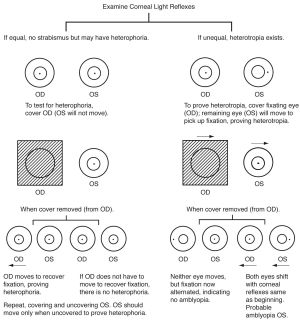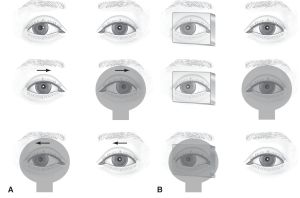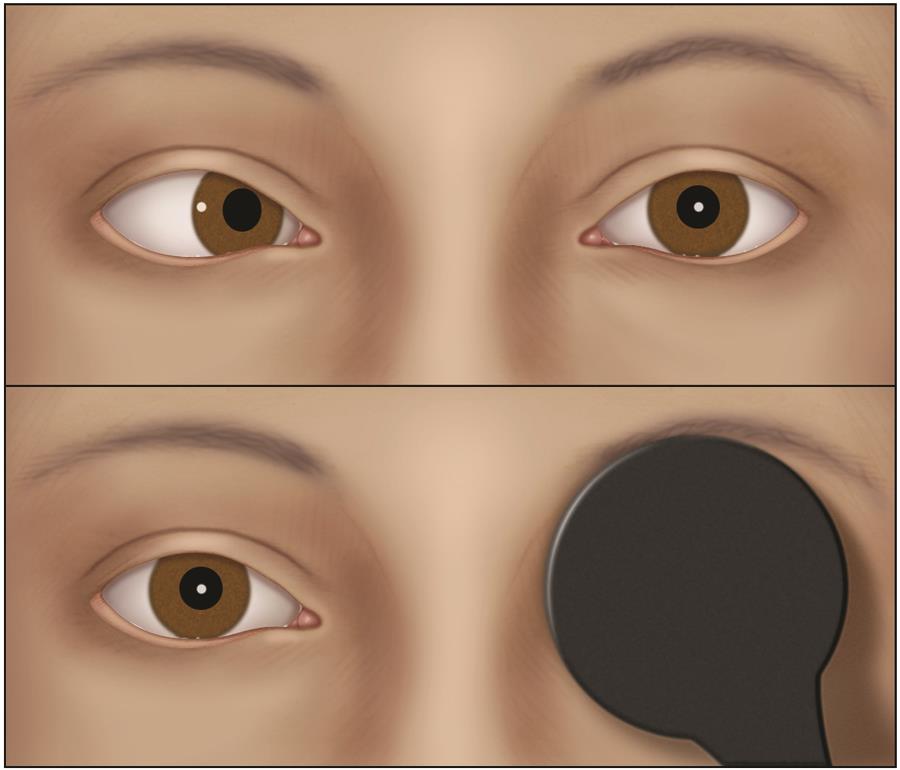Cover Tests
All content on Eyewiki is protected by copyright law and the Terms of Service. This content may not be reproduced, copied, or put into any artificial intelligence program, including large language and generative AI models, without permission from the Academy.
Diagnostic Procedures
Cover testing is the gold standard for the objective method of determining the presence, type, and magnitude of ocular misalignment (strabismus). It is typically performed by the ophthalmologist, orthoptist, or ophthalmic technician. Cover testing can be done at both near and distance. When performed at near, an accommodative fixation target is held at a distance of 33 cm. At distance, the patient fixates on a target at a distance of 6 m.
Cover-Uncover Test
The cover-uncover test is generally performed first. This test is useful to identify a tropia and differentiate it from a phoria. The test is performed by using an opaque or translucent occluder to cover one eye. The occluder is held in front of the eye for a few seconds and then removed. When the fixing eye is occluded, the examiner will observe the nonoccluded eye move to pick up fixation if a tropia is present. If no tropia is present, the nonoccluded eye will remain stationary. To assess for a phoria, or latent deviation, the examiner observes the eye behind the occluder. If a phoria is present, the uncovered eye does not move; however, the eye that is behind the occluder will deviate and return to a straight position when the occluder is removed.

Alternate Cover Test
The alternate cover test is generally performed after the cover-uncover test. The alternate cover test is the most dissociative cover test and measures the total deviation, which includes the tropia plus the phoria. For this test, the examiner occludes one eye and then the other, switching the occluder back and forth between eyes. When performing the alternate cover test, it is important to hold the occluder over each eye for at least a few seconds in order to allow the nonoccluded eye enough time to pick up fixation. In general, the faster the eyes are able to recover when the occluder is switched, the better the control of the deviation.

Alternate Prism Cover Test
The alternate prism cover test is similar to the alternate cover test, with the addition of a prism held over one eye to quantify the misalignment. The examiner performs the alternate cover test while changing the prism over the deviated eye until the misalignment is neutralized. The magnitude of the deviation is the measurement of the prism in prism diopters required to neutralize the deviation.
References
- ↑ American Academy of Ophthalmology. Cover test. https://www.aao.org/image/cover-test-4 Accessed February 17, 2023.
- ↑ American Academy of Ophthalmology. Cover test. https://www.aao.org/image/cover-test-5 Accessed February 17, 2023.
- ↑ American Academy of Ophthalmology. Alternate cover test. https://www.aao.org/image/alternate-cover-test-2 Accessed February 17, 2023.


